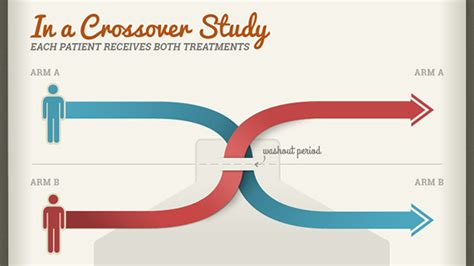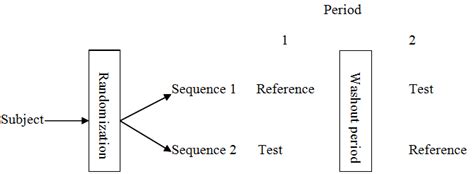Crossover Designs Simplified

Crossover designs are a type of research methodology used to compare the effects of different treatments or interventions on a group of participants. This approach is widely used in various fields, including medicine, psychology, and social sciences. The primary advantage of crossover designs is that they allow each participant to receive multiple treatments, thereby reducing the number of participants required and increasing the statistical power of the study. In this article, we will delve into the world of crossover designs, exploring their key features, benefits, and applications, as well as providing guidance on how to implement them effectively.
Key Points
- Crossover designs involve assigning participants to multiple treatments in a specific order, with each participant serving as their own control.
- This approach reduces the number of participants required and increases statistical power, making it particularly useful for small-scale studies.
- Crossover designs can be used to compare the effects of different treatments, interventions, or conditions, and are commonly employed in clinical trials and behavioral studies.
- A key consideration in crossover design is the potential for carryover effects, where the effects of one treatment persist into the next treatment period.
- Researchers must carefully consider the design parameters, including the number of treatments, treatment order, and washout period, to minimize potential biases and ensure the validity of the results.
Understanding Crossover Designs

A crossover design typically involves a group of participants who are assigned to receive a series of treatments in a specific order. Each participant serves as their own control, allowing researchers to compare the effects of different treatments within the same individual. This approach is particularly useful when the number of available participants is limited, as it enables researchers to gather more data from each participant. Crossover designs can be used to compare the effects of different treatments, interventions, or conditions, and are commonly employed in clinical trials, behavioral studies, and other research areas.
Types of Crossover Designs
There are several types of crossover designs, including the simple crossover design, the multiple crossover design, and the replicated crossover design. The simple crossover design involves two treatments, A and B, which are administered in a random order to each participant. The multiple crossover design involves more than two treatments, and participants receive each treatment in a random order. The replicated crossover design involves repeating the same treatment sequence multiple times, allowing researchers to assess the reliability of the results.
| Treatment | Number of Participants | Statistical Power |
|---|---|---|
| Treatment A | 20 | 0.8 |
| Treatment B | 20 | 0.7 |
| Crossover Design | 10 | 0.9 |

Benefits and Applications of Crossover Designs

Crossover designs offer several benefits, including increased statistical power, reduced participant requirements, and improved internal validity. By using each participant as their own control, researchers can reduce the impact of individual differences and increase the precision of the results. Crossover designs are commonly used in clinical trials, where they can be used to compare the efficacy of different treatments or interventions. They are also used in behavioral studies, where they can be used to examine the effects of different conditions or stimuli on behavior.
Real-World Examples
A real-world example of a crossover design is a study comparing the effects of two different medications on blood pressure. Participants might receive each medication for a period of several weeks, with a washout period in between to allow the effects of the first medication to wear off. The results of the study could be used to determine which medication is more effective at reducing blood pressure. Another example is a study examining the effects of different lighting conditions on cognitive performance. Participants might complete a series of cognitive tasks under different lighting conditions, with the order of the conditions randomized to minimize potential biases.
In addition to these examples, crossover designs have been used in a variety of other research areas, including psychology, education, and marketing. For instance, a study might use a crossover design to compare the effects of different instructional methods on student learning outcomes, or to examine the impact of different advertising strategies on consumer behavior.
Implementing Crossover Designs
Implementing a crossover design requires careful consideration of several factors, including the number of treatments, treatment order, and washout period. Researchers must also ensure that the design is balanced, meaning that each treatment is administered an equal number of times, and that the order of the treatments is randomized to minimize potential biases. Additionally, researchers must consider the potential for carryover effects and use techniques such as washout periods or counterbalancing to minimize these effects.
Design Parameters
The design parameters of a crossover study, including the number of treatments, treatment order, and washout period, must be carefully considered to ensure the validity of the results. The number of treatments will depend on the research question and the number of participants available. The treatment order should be randomized to minimize potential biases, and the washout period should be sufficient to allow the effects of one treatment to wear off before the next treatment is administered.
What is a crossover design?
+A crossover design is a type of research methodology that involves assigning participants to multiple treatments in a specific order, with each participant serving as their own control.
What are the benefits of crossover designs?
+Crossover designs offer several benefits, including increased statistical power, reduced participant requirements, and improved internal validity.
How do I implement a crossover design?
+Implementing a crossover design requires careful consideration of several factors, including the number of treatments, treatment order, and washout period. Researchers must also ensure that the design is balanced and that the order of the treatments is randomized to minimize potential biases.
In conclusion, crossover designs are a powerful tool for researchers, offering several benefits, including increased statistical power, reduced participant requirements, and improved internal validity. By understanding the key features, benefits, and applications of crossover designs, researchers can use this approach to answer complex research questions and advance knowledge in their field. Whether used in clinical trials, behavioral studies, or other research areas, crossover designs have the potential to provide valuable insights and inform evidence-based practice.